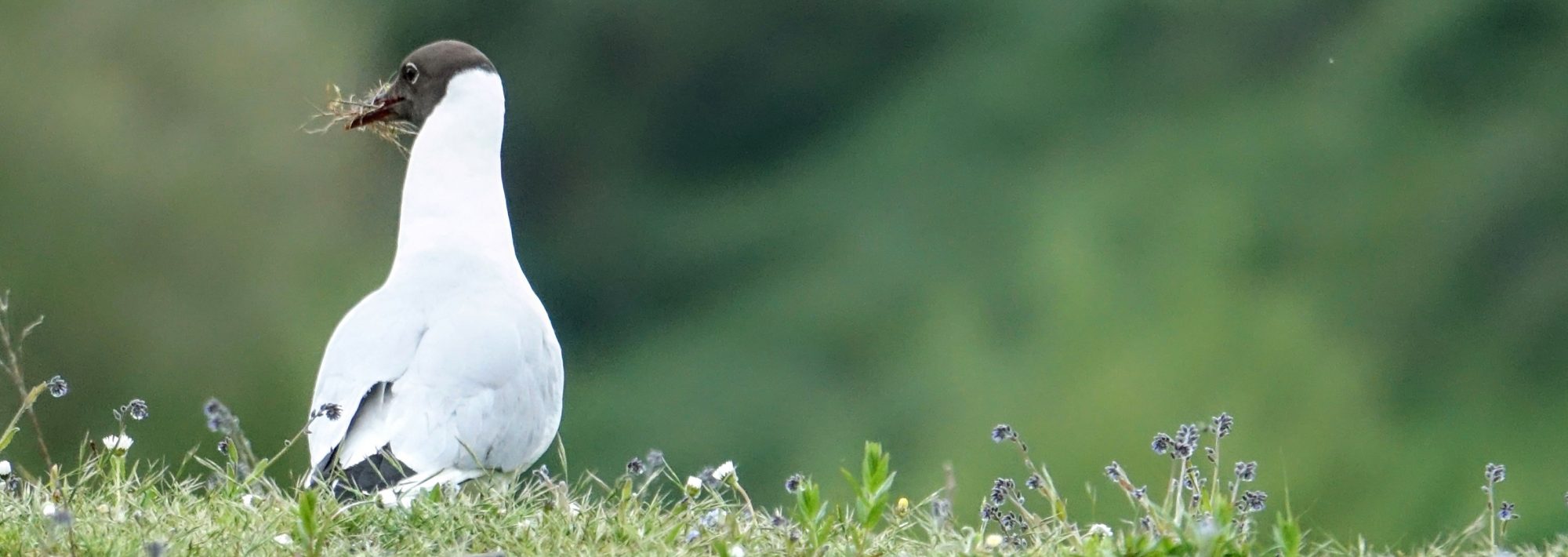This page provides brief information on the following Shropshire birding sites. Click on the site name for more details.
This large shallow pool, managed as a wetland site for waterfowl and waders, is owned by the Shropshire Ornithological Society. It is 10 km to the south-east of Shrewsbury with access off the A458 Shrewsbury to Much Wenlock road. Three public hides give excellent views over the main pool and there is also a members-only hide. The site has a car park and disabled access via a wheelchair ramp into the main hide.
For more detailed information about this site, click here.
Eardington Nature Reserve (NGR SO725900)
This local nature reserve was acquired by Shropshire Council in 2013 on a long term lease and lies two miles south of Bridgnorth on the B4555 (Highley Road).
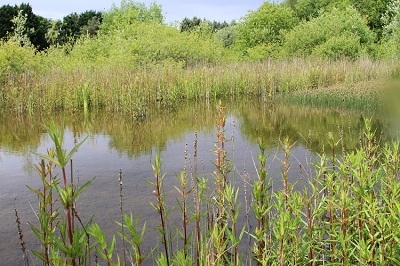
Eardington Nature Reserve
A former quarry, the site consists of an open mosaic habitat with a large central area of nutrient poor sands and gravels. Within this are found both seasonal and permanent ponds with good populations of amphibians (toads, great crested and common newt). There are also numerous dragonfly and damselfly species together with a wide range of wild flowers. Other habitats surrounding the gravels include species-rich meadows, scrub and woodlands.
Species lists are online at http://www.fenr.org.uk/species/bird-species/. The range of bird species is encouraging with 70 so far recorded. Similarly, the butterfly population is healthy, totalling 23 species and includes the locally scarce brown argus. Reptiles are present and include slow worm and grass snake. A survey of solitary bee species is producing some rare and interesting specimens. Our recently constructed solitary bee village will support the range and abundance of species present.
Good close views of our woodland birds can be enjoyed from the bird hide and feeding station. For example, marsh tit is resident and seen most days; willow tit is an occasional visitor and lesser redpoll and siskin are both seasonally common.
Access for those with impaired mobility is good. Radar gates have now been installed and the paths are wide with a good surface, giving access the most of the reserve, including the bird hide. (Ian Barrie, Chair, FENR, 2018)
Haughmond Hill (NGR SJ545148 – car park)
This site is owned by the Forestry Commission who manage it as a coniferous woodland. However, the steep slopes overlooking Shrewsbury, with distant views of the South Shropshire hill country, are more open grassland with some deciduous woodland. The Forestry Commission maintain a series of marked trails, including an “all ability” trail suitable for wheelchair users, although this trail does not go as far as the escarpment. The coniferous woodland yields Goldcrest, Coal Tit, Willow Tit and the occasional Crossbill. The areas of deciduous woodland have Green and Great Spotted Woodpeckers, Kestrel and Raven, and Peregrine is occasionally seen. Woodcock display over the woodland on summer evenings.
Whitcliffe Common (NGR SO506743)
Being close to the town of Ludlow, this is a popular dog-walking area for the locals but is worth a visit for both birding and the view from the common looking over the Teme valley to Ludlow Castle. The main habitat is woodland with the River Teme flowing below in a steep sided valley. There are several paths around the common and in the woodland which will produce most of the common woodland birds appropriate to the time of year, with the walk along the river being the the most productive. This site was once known among birders for its wintering flock of Hawfinches. This elusive finch could be found feeding in or under the hornbeams that grace this site near Dinham Bridge, look back towards the Common. While you watch, check out the riverside alders for Siskin and Redpoll. The river may hold interesting birds such as Dipper and Kingfisher; check the areas near to the weirs – Mandarin Duck have been noted here in recent years. If you visit in spring you may locate Wood Warbler among the beeches on the Common. In summer the area can be very busy with visitors taking the air and this is the least interesting time for birders but still worth a visit if you are in the area. By autumn the tit and finch flocks will have built up and the winter thrushes will be starting to arrive. To get to the area leave Ludlow going south on the B4361 and, after crossing the Teme at Ludford Bridge, turn right into Wigmore Road. Park in the designated car park on the left or on the road adjacent to the Common. Note that the paths down to the riverside are steep in places and can be slippery in wet weather. (Based on notes by Andy Latham)
Wood Lane Nature Reserve (NGR SJ421331)
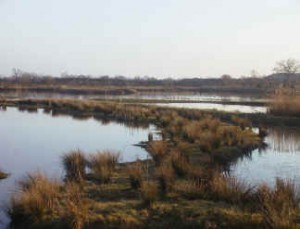
Wood Lane Nature Reserve
This wetland site has been created from part of a large sand and gravel quarry complex and contains a series of pools, some shallow and some deep, which attract a range of wildfowl, waders and many passerines. It is one of the best places to see Shelduck, which now breed in the area. There is a small car park and two hides overlooking the best pools (the picture to the right is the view from the small hide).
A grass meadow has been created which attracts butterflies in the summer.
Access is by permit, which can be obtained from the Shropshire Wildlife Trust.
Wall Farm on the Weald Moors (north of Telford) (NGR SJ681178)
Wall Farm is situated near Kynnersley, Telford. It is a working farm and is cultivated under the Countryside Stewardship scheme to a plan set out by the RSPB. Its aims are to encourage wetland breeding birds such as Lapwing, Redshank, Curlew and Snipe. A hide has been built, at grid reference SJ677181, overlooking a marsh and pools created by reversing the pumps previously used to drain the land. The surrounding farmland is mostly pasture and hay meadow for beef cattle and sheep.
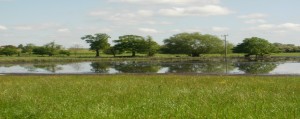
Wall Farm
2014 was a particularly good year, with a wet spring flooding fields between Buttery Lane and Wall Farm Cottage. This attracted Avocet, Black-tailed Godwit, Wood Sandpiper, Grey Plover, Little Ringed Plover (max 7 on 5th May), Ringed Plover (max 30 on 7th May), Sanderling, Dunlin (max 13 on 11th May), a pair of Ruff, a pair of Garganey and also breeding Shelduck and Oystercatcher.
Other breeding birds on the marsh include Little Grebe, Tufted Duck, Mallard, Canada Goose, Moorhen and Coot. Barn Owl is present and is being actively encouraged to breed by the provision of nest boxes by the Shropshire Barn Owl Group. Buzzard, Raven and Corn Bunting also breed in the surrounding area and are regularly recorded. Summer visitors include Hobby, Quail, Yellow Wagtail, Sedge and Reed Warbler, Common and Lesser Whitethroat, as well as the other commoner warblers.
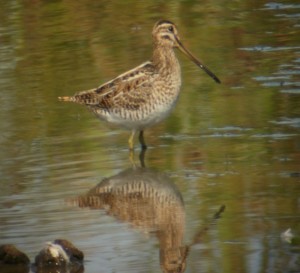
Common Snipe at Wall Farm
Passage birds include Black-tailed Godwit, Garganey, Shelduck and Oystercatcher.
Winter sees the arrival of wildfowl to the marsh, including large numbers of Teal, as well as Wigeon, Shoveler, Gadwall, Snipe, Water Rail and Stonechat.
The surrounding fields and hedges attract large flocks of Fieldfare, Starling and Woodpigeon that, in turn, attract the attentions of Peregrine and Sparrowhawk. Flocks of Linnet, Yellowhammer, Reed Bunting, Corn Bunting and Brambling feed on the set-aside planted with wild bird seed.
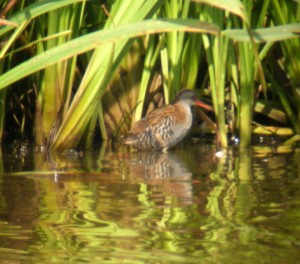
Water Rail at Wall FarmThe bird list for Wall Farm since the hide was opened in November 1998 numbers 158 species. Rarities include Temminck’s Stint (16th to 18th August 2003), Bewick’s Swan (10 on 26th to 30th March 2006), Steppe Grey Shrike (28th October to 9th November 2011), Great Egret (1 on 13th May 2013), Glossy Ibis (29th September 2013) and pair of Common Crane (4th to 5th May 2014).
Access to the site is permitted to SOS members by kind permission of the owners Neil and Stephanie Dobson. Wall Farm can be found by taking the road to Preston upon the Weald Moors off the Leegomery island on the A442 in Telford. Just after the Queens Head pub, turn left into the village of Preston upon the Weald Moors, then on to Kynnersley. On entering Kynnersley village, turn right by the telephone box; after about a 1.5 km you will pass the Wall Farm Cottages and the farm is the next on the right. Park in the farm drive, close to the wall to allow access for tractors, not on the roadside verges. To get to the hide, walk back towards Wall Farm Cottages until you come to a wicket gate on your right. The hide is through the gate, down the field and along the footpath running alongside the hedgerow. Please record your sightings in the log book provided. (Martin Grant 2015)
Chelmarsh Reservoir (NGR SO726881)
This reservoir, operated by South Staffordshire Water Authority, is maintained by pumping water from the nearby Severn, which keeps much of the water surface open in severe weather when most other pools are frozen. The reservoir is one of the best places for wildfowl in the County and the marsh at the north end has an impressive species list – an excellent place for Water Rail and a colony of Reed Warblers. Chelmarsh is also good to see Osprey passing through on passage, especially in the autumn. The gull roost is also worth a visit during the winter months, with over 10,000 birds regularly recorded, including a selection of the rarer gulls. Access is restricted to public rights of way and the path to the scrape requires a permit from the SOS.
The grid reference is for Pole Bank on the top of the Long Mynd, a large area of upland, 6 km wide in the north and extending 10 km southwards, gradually narrowing down to the tip at Plowden. Much of the area is managed by the National Trust which has a visitor centre in Carding Mill Valley (SO443946), close to Church Stretton. A few roads give access to the higher land where there is limited parking but the country is best seen by walking up one of the many valleys which intersect the hillsides. Carding Mill Valley can be busy with visitors in summer but most visitors stay in the lower parts of the valley. Together with the Stiperstones to the west, these hills are a good place for upland species like Meadow Pipit, which are common, and Merlin, which is rarer. Ravens and Red Kites are increasing in number, Buzzard and Kestrel are regularly seen whilst Hobby is often noted in summer. The slopes of the Long Mynd may provide views of Ring Ouzel in passage but this species no longer breeds here. Hen Harrier occasionally turn up, especially on passage, as do Dotterel, mainly in spring but numbers vary from year to year.
The Priorslee Flash (NGR SJ711102)
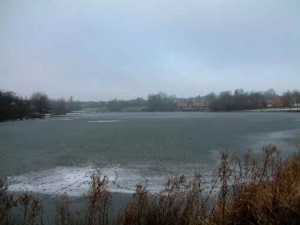
West Shore, Priorslee
This urban lake has been in existence for about 20 years and is artificial but is based on three natural ponds. Access can be gained from Priorslee Avenue onto Derwent Drive by car and/or on foot via the underpass from the far side of the A5 (St George’s By-Pass). The best viewing areas are from the south and north shores (away from the picnic area on the west shore). The island is the main breeding site for waterfowl. Birds seen include Great Crested Grebe, Tufted Duck, Mandarin, Ruddy Duck, Pochard, Goldfinch, Jay, Sparrowhawk, Blackcap, Wood Warbler and Chiffchaff. Gulls are occasional. The woods on the south west and north east have many small birds. This is a good site for birding all year round. (Swaran Jagdev)
Priorslee Balancing Lake (NGR SJ726093)
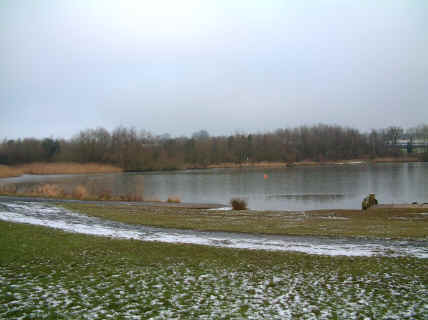
North Shore, Priorslee
This lake is used mainly by the Telford Sailing Club and so gets very busy in the summer but is nevertheless good for birding, mainly in the winter, for both water and shrubland species. Birds seen include Cormorant, Grey Heron, Great Crested Grebe, Shoveler, Teal, Pochard, Tufted Duck, Goosander, Ruddy Duck, Jay, Sparrowhawk and Chiffchaff. This lake acts as an exceptional roost for gulls, including Black-headed, Lesser Black-backed, Great Black-backed, Herring, and Common Gulls, and also occasionally terns. The lake can be viewed from the dam on the east shore from J4 M54 onto Castle Farm Way and the lay-by on the left or the south shore (SJ722094), accessed by walking the south shore, or from Priorslee Avenue onto Teece Drive. This site is good all year but especially for gulls in the winter. (Swaran Jagdev)
Severn Valley Country Park (Visitor Centre at NGR SO753839)
This site largely results from a massive reclamation project following the closure of Alveley colliery in 1969 and is a short car or bus journey from Dudmaston (SO745888) and Chelmarsh Reservoir (SO726881). The colliery bridge (SO748839) does provides pedestrian access to both banks of the Severn and to the Severn Valley Railway at Highley.
The extensive colliery spoil heaps have been landscaped with native deciduous saplings and contain an unusual mixture of rural and wasteland flowers together with terrestrial lichens more often found on heathland. Other habitats include the river itself, birch woods, open scrub, meadows, formal grassland and a private golf course.
Many common woodland species breed here, as do Willow Tit and an occasional Lesser Spotted Woodpecker. Raven breeds increasingly and Sedge Warbler is attempting to colonise the riverside. Barn Owl nests nearby and Quail are sometimes heard in the surrounding fields. Turtle Dove ceased to breed annually in 2004 but may yet reappear.
In winter, the spoil heaps attract Meadow Pipit and sizable Goldfinch flocks, the riverside trees often contain good numbers of Siskin and Redpoll, and the river often holds Goosander with occasional Mandarin and Dipper. Peregrine visits increasingly, as does Hobby during the summer. Choice migrants are unusual but Wheatear, Yellow Wagtail and Common Sandpiper appear to be annual.
In recent years, the hide and small pools near the visitor centre (SO754839) and Little London Farm (SO756836) have hosted Bittern, Stonechat, Woodcock, Greenshank, Water Rail, Jack Snipe, Snipe, Wigeon, Shoveler, Redstart, Reed Warbler and Little Grebe, but they are rarely productive unless visited regularly. Kingfisher sometimes visits from the river and a pair of Reed Bunting usually breeds nearby.
Dragonflies include Club-Tailed and an occasional Hairy Hawker. Look for Wild Parsnip and Greater Spearwort which are rarely found elsewhere in the County; Common Spotted Orchid is a more expected attraction. Toadstools include the bizarre Collared Earthstar. Otter, Mink and Muntjac Deer are very occasionally reported.
The park can be very busy in summer and at weekends. Wheelchair access is theoretically good but ascents from the river would be very strenuous. There is free parking near the Alveley visitor centre (SO753839) or, from Highley, consider taking Barke Street (SO741834) and parking near the railway line. (Keith Bates)
Chetwynd Pool can be found to the north of Newport by taking the old main road out of Newport town centre towards Chetwynd church. As you are leaving Newport the pool is behind the wall on your left, at the end of a straight park on the right, just before a small wood. The car park is a favourite spot for dog-walkers and there are footpaths along the field side of the wood and up the hill, to the east, by the side of another wood. To view the pool, cross over the road and walk back towards Newport; the pool can be seen over the park wall for a 100 m stretch. This can give very good views in winter (when there are no leaves on the trees) of Shoveler, Wigeon and occasionally Goosander. As well as the wildfowl on the pool, other birds of interest include all three species of woodpecker, Nuthatch, Treecreeper, Raven and Buzzard.
The park is owned by the Newport Agricultural Show Committee and is only open to the public on Show days, for two days in July and at Whitsun for the Game Fair. There is a public footpath along the southern edge of the park over a style on the right just after the park warden’s cottage. This footpath takes you to the B5062, which you can follow up the hill towards Edgmond. When you come to the park entrance gate turn right along a lane that will take you to Chetwynd church. Turn right and follow the footpath alongside the park wall until you get back to the car park. This walk is about 5 km long so, if you don’t want to walk this far, turn back when you reach the park warden’s cottage and retrace your steps back to the car park. (Martin Grant)
Howle Pool can be found by taking the A41 from Newport towards Hinstock. Turn left at the cross roads, just after the filling station at Standford Bridge. Follow the road for a mile until you see the pool on your right. Pull in on the left and view the pool from the roadside. Little Grebe and Ruddy Duck are regular breeders here. (Martin Grant)
Polemere Nature Reserve (NGR SJ41310939)
Polemere is about 10 km south-west of Shrewsbury. This small pool in farmland is a private reserve but is open to the public – for more information follow this link.
Adding to this Site List
Do you have a bird watching site that you would like to share with others? If so, contact the web manager.
